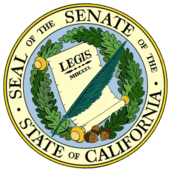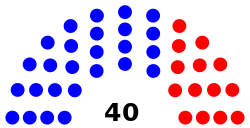California State Senate
Coordinates: 38°34′36″N 121°29′37″W / 38.57667°N 121.49361°W
| California State Senate | |
|---|---|
| California State Legislature | |
 | |
| Type | |
| Type | |
Term limits |
Elected before 2012: 2 terms (8 years) Elected 2012 and after: 3 terms (12 years) |
| History | |
New session started | December 1, 2014 |
| Leadership | |
Majority Leader | |
Minority Leader | |
| Structure | |
| Seats | 40 |
 | |
Political groups | |
Length of term | 4 years |
| Authority | Article 4, California Constitution |
| Salary | $95,291/year + per diem |
| Elections | |
Last election | November 6, 2014 (20 seats) |
Next election | November 8, 2016 (20 seats) |
| Redistricting | California Citizens Redistricting Commission |
| Motto | |
|
Senatoris est civitatis libertatem tueri ("It is a senator's duty to protect the liberty of the people.") | |
| Meeting place | |
 | |
|
State Senate Chamber California State Capitol Sacramento, California | |
| Website | |
|
www | |
The California State Senate is the upper house of the California State Legislature. The legislative body consists of 40 members, with each member representing approximately 931,000 people. Due to the state's large population and relatively small legislature, the State Senate has the largest population per representative ratio of any state legislative house. In the United States House of Representatives, California is apportioned 53 representatives, each representing approximately 704,566 people,[1] while in the State Senate, each of the 40 Senators represents approximately 931,349 people,[2] with the result that California state senators each actually represent more voters than California's representatives to the United States Congress do. Each member roughly represents a population equivalent to the state of Delaware. As a result of Proposition 140 in 1990 and Proposition 28 in 2012, members elected to the legislature prior to 2012 are restricted by term limits to two four-year terms (eight years), while those elected in or after 2012 are allowed to serve 12 years in the legislature in any combination of four-year state senate or two-year state assembly terms.[3]
The State Senate convenes at the California State Capitol in Sacramento.
In the current session, Democrats control 26 seats, while Republicans control 13. Twenty-seven seats, or two-thirds, are needed for a super-majority.
History
Prior to 1968, state senate districts were drawn so that each county had at most one state senator. This led to the situation of a populous county such as Los Angeles County being accorded the same number of state senators (1) as less populous counties such as Humboldt County. In Reynolds v. Sims, the United States Supreme Court compelled all states to draw up districts with equal population. As such, boundaries were changed to provide more equitable representation.
Leadership
The Lieutenant Governor is the ex officio President of the Senate and may break a tied vote. The President pro tempore is elected by the majority party caucus, followed by confirmation of the full senate. Other leaders, such as the majority and minority leaders, are elected by their respective party caucuses according to each party's strength in the chamber.
The current president pro tem is Democrat Kevin de León (22nd–Los Angeles). The minority leader is Republican Jean Fuller (16th–Bakersfield).
Meeting chamber
The red tones of the California State Senate Chamber are based on the British House of Lords, which is outfitted in a similar color. The dais rests along a wall shaped like an "E", with its central projection housing the rostrum. Along the cornice appears a portrait of George Washington and the Latin quotation: senatoris est civitatis libertatem tueri ("It is a senator's duty to protect the liberty of the people"). Almost every decorating element is identical to the Assembly Chamber.
Officers
| Position | Name | Party | District | |
|---|---|---|---|---|
| President of the Senate | Gavin Newsom | Democratic | ||
| President pro tempore | Kevin de León | Democratic | 24th–Los Angeles | |
| Majority leader | Bill Monning | Democratic | 17th–Carmel | |
| Majority whip | Lois Wolk | Democratic | 3rd–Davis | |
| Majority caucus chair | Connie Leyva | Democratic | 20th–Chino | |
| Majority caucus vice chair | Mike McGuire | Democratic | 2nd–Healdsburg | |
| Minority leader | Jean Fuller | Republican | 16th–Bakersfield | |
| Minority caucus chair | Tom Berryhill | Republican | 8th–Twain Harte | |
| Minority caucus whip | Ted Gaines | Republican | 1st–Roseville | |
| Minority caucus assistant whip | Patricia Bates | Republican | 36th–Laguna Niguel | |
| Secretary | Daniel Alvarez | |||
| Sergeant-at-Arms | Debbie Manning | |||
| Chaplain | Sister Michelle Gorman | |||
The Secretary, the Sergeant-at-Arms, and the Chaplain are not members of the Legislature.
Composition

| | ||
| 26 | 1 | 13 |
| Democratic | V | Republican |
| Affiliation | Party (Shading indicates majority caucus) |
Total | |||
|---|---|---|---|---|---|
| Democratic | Republican | Vacant | Suspended | ||
| End of previous legislature | 25 | 12 | 37 | 1 | 2 |
| Begin[4] | 25 | 14 | 39 | 1 | 0 |
| December 10, 2014[5] | 26 | 40 | 0 | ||
| January 2, 2015[6] | 25 | 39 | 1 | ||
| January 3, 2015[7] | 13 | 38 | 2 | ||
| January 5, 2015[8] | 12 | 37 | 3 | ||
| March 19, 2015[9] | 13 | 38 | 2 | ||
| March 22, 2015[10] | 14 | 39 | 1 | ||
| May 28, 2015[11] | 26 | 40 | 0 | ||
| July 14, 2016[12] | 13 | 39 | 1 | ||
| Latest voting share | 66.7% | 33.3% | |||
Seating chart
Committees
Current committees include:[13]
Standing
- Senate Committee on Agriculture
- Senate Committee on Appropriations
- Senate Appropriations Subcommittee on Fiscal Oversight and Bonded Indebtedness
- Senate Committee on Banking and Financial Institutions
- Senate Committee on Budget and Fiscal Review
- Senate Budget Subcommittee No. 1 on Education
- Senate Budget Subcommittee No. 2 on Resources
- Senate Budget Subcommittee No. 3 on Health and Human Services
- Senate Budget Subcommittee No. 4 on State Administration and General Government
- Senate Budget Subcommittee No. 5 on Corrections
- Senate Committee on Business, Professions and Economic Development
- Senate Committee on Education
- Senate Education Subcommittee on Sustainable School Facilities
- Senate Committee on Elections and Constitutional Amendments
- Senate Committee on Energy, Utilities and Communications
- Senate Committee on Environmental Quality
- Senate Committee on Governmental Organizations
- Senate Committee on Governance and Finance
- Senate Committee on Health
- Senate Committee on Human Services
- Senate Committee on Insurance
- Senate Committee on Judiciary
- Senate Committee on Labor and Industrial Relations
- Senate Committee on Legislative Ethics
- Senate Committee on Natural Resources and Water
- Senate Natural Resources and Water Subcommittee on Urban Rivers
- Senate Committee on Public Employment and Retirement
- Senate Committee on Public Safety
- Senate Committee on Rules
- Senate Committee on Transportation and Housing
- Senate Committee on Veterans Affairs
Joint
- Joint Committee on Arts
- Joint Committee on Fairs, Allocation and Classification
- Joint Committee on Fisheries and Aquaculture
- Joint Committee on Legislative Audit
- Joint Committee on Rules
- Joint Legislative Budget
- Joint Legislative Committee on Emergency Management
Offices
- Senate Office of Research
- Senate Office of Demographics
- Senate Office of Floor Analysis
- Senate Office of International Relations
- Senate Office of Oversight and Outcomes
See also
- Bill (proposed law)
- California State Senate districts
- California State Senate elections, 2012
- California State Assembly
- California State Capitol
- California State Capitol Museum
- California State Legislature
- Districts in California
- Members of the California State Legislature
References
- ↑ "Apportionment Data". United States Census Bureau.
- ↑ "Senate Roster". State of California.
- ↑ "Article 4. Legislative". California Constitution. California Legislative Counsel. Retrieved December 1, 2012.
- ↑ Vacant since September 22, 2014 when Democrat Rod Wright (District 35) resigned to serve a jail sentence after conviction for perjury and voter fraud.
- ↑ Democrat Isadore Hall, III sworn in to succeed Wright.
- ↑ Democrat Mark DeSaulnier (District 7) resigned to take office in Congress.
- ↑ Republican Mimi Walters (District 37) resigned to take office in Congress.
- ↑ Republican Steve Knight (District 21) resigned to take office in Congress.
- ↑ Republican Sharon Runner sworn in to succeed Knight.
- ↑ Republican John Moorlach sworn in to succeed Walters.
- ↑ Democrat Steve Glazer sworn in to succeed DeSaulnier.
- ↑ Republican Sharon Runner (District 21) died.
- ↑ "California Senate Committees". Open States. Sunlight Foundation. 2014-04-09. Retrieved 2014-04-09.
External links
- Official website of the California State Senate
- Map of the state senate districts
- California legislative district maps from 1849 to the present